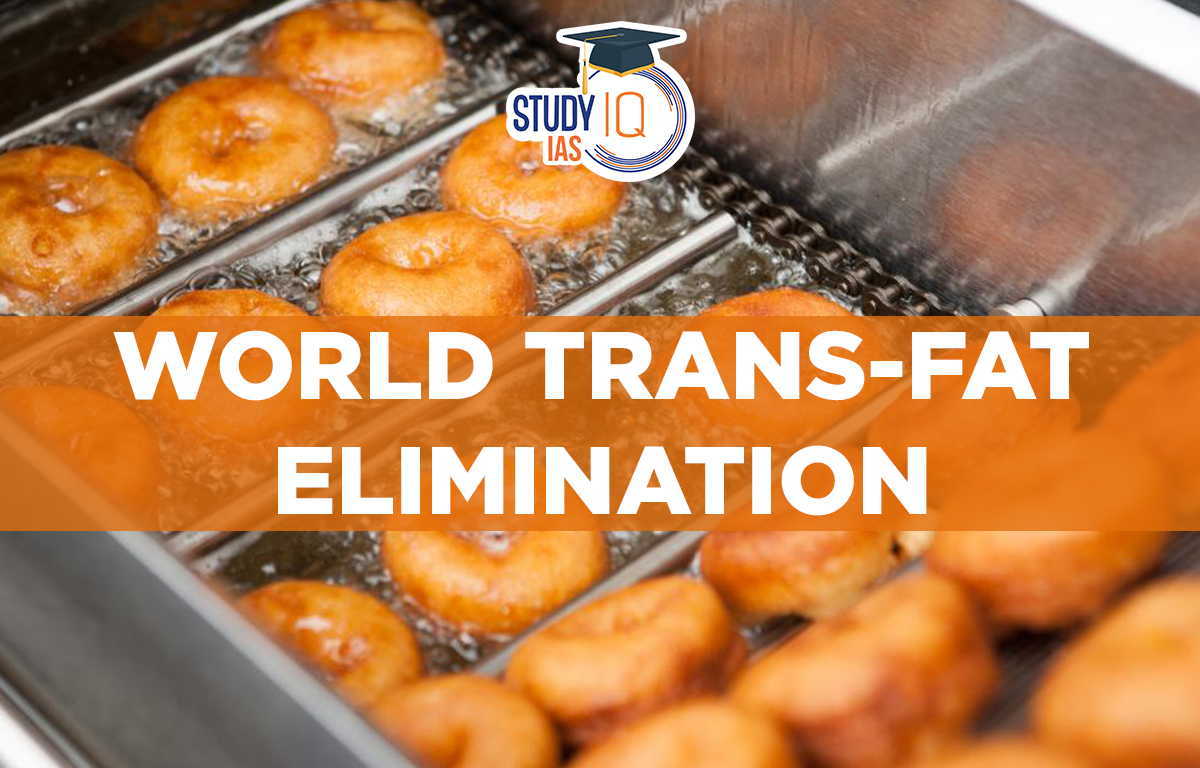Table of Contents
In News: A new status report from WHO has found that five billion people globally remain unprotected from harmful trans-fat, increasing their risk of heart disease and death.
More on World Trans-Fat Elimination
- WHO first called for the global elimination of industrially produced trans-fat in 2018, with an elimination target set for 2023.
- Since then the population coverage of best-practice policies has increased almost six-fold.
- Despite substantial progress, about 5 billion people worldwide are at risk from trans-fat’s devastating health impacts with the global goal for its total elimination in 2023 remaining unattainable.
Key Findings of the Report
- The consumption of trans fats, which can be found in packaged foods, baked goods, cooking oils and spreads, is responsible for up to half a million premature deaths from heart disease every year.
- Trans-fats increase LDL cholesterol and decrease HDL cholesterol, which can increase the risk of heart attack or stroke.
- 43 countries have now implemented best-practice policies for tackling trans-fat in food, with 2.8 billion people protected globally.
- Many countries in America and Europe have phased the substance out with bans on partially hydrogenated oils.
- However, no low-income countries have yet adopted such measures.
- Currently, 9 of the 16 countries with the highest estimated proportion of coronary heart disease deaths caused by trans-fat intake do not have a best-practice policy.
- These include Australia, Azerbaijan, Bhutan, Ecuador, Egypt, Iran (Islamic Republic of), Nepal, Pakistan and the Republic of Korea.
- Trans-fat elimination policies follow specific criteria established by WHO and limit industrially produced trans-fat in all settings.
- Mandatory national limit of 2 grams of industrially produced trans-fat per 100 grams of total fat in all foods;
- Mandatory national ban on the production or use of partially hydrogenated oils as an ingredient in all foods.

About Trans-Fat
- Trans-fats, or trans-fatty acids, are a form of unsaturated fat. They come in both natural and artificial forms.
- Natural, or ruminant, trans-fats occur in the meat and dairy from ruminant animals, such as cattle, sheep, and goats. They form naturally when bacteria in these animals’ stomachs digest grass.
- However, artificial trans-fats otherwise known as industrial trans-fats or partially hydrogenated fats are hazardous to health.
- These fats occur when vegetable oils are chemically altered to stay solid at room temperature, which gives them a much longer shelf life.
- Added trans-fats increase the risk of heart attacks, stroke and type 2 diabetes. Trans-fats also have an unhealthy effect on cholesterol levels.
- There are two main types of cholesterol:
- Low-density lipoprotein (LDL) cholesterol: LDL, or “bad,” cholesterol can build up in the walls of arteries, making them hard and narrow.
- High-density lipoprotein (HDL) cholesterol: HDL, or “good,” cholesterol picks up excess cholesterol and takes it back to the liver.

Policies to Eliminate Trans Fat:
- REPLACE, a step-by-step guide for the elimination of industrially-produced trans-fatty acids from the global food supply was released by WHO.
- REPLACE provides six strategic actions to ensure the prompt, complete, and sustained elimination of industrially-produced trans fats from the food supply:
India:
- Eat Right Movement: Launched in 2018, the programme is built on two broad pillars of ‘Eat Healthy’ and ‘Eat Safe’.
- Heart Attack Rewind: The objective of the campaign was to warn citizens about the health hazards of consuming trans-fats and offer strategies to avoid them through healthier alternatives.
- Swachh Bharat Yatra: A Pan-India cyclothon, was launched under the movement to educate citizens on issues of food safety, combating food adulteration and healthy diets.
- The FSSAI has stated that all food items should contain less than 2% of trans-fat from Jan 2022.


 UNEP Champions of the Earth Award: UN's ...
UNEP Champions of the Earth Award: UN's ...
 Shilp Didi Programme: Empowering Women A...
Shilp Didi Programme: Empowering Women A...
 Is the Falling Rupee a Cause for Alarm?
Is the Falling Rupee a Cause for Alarm?

























